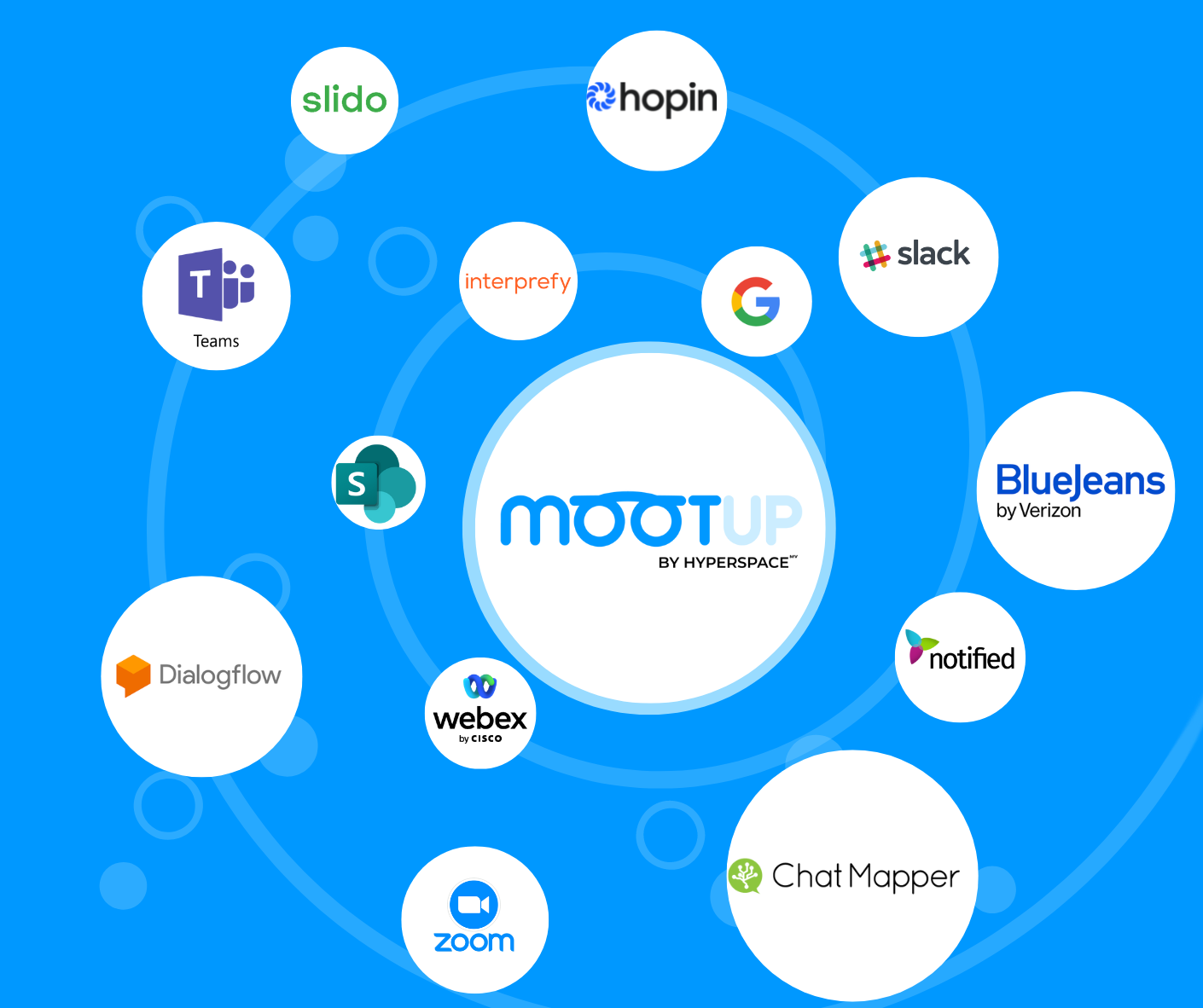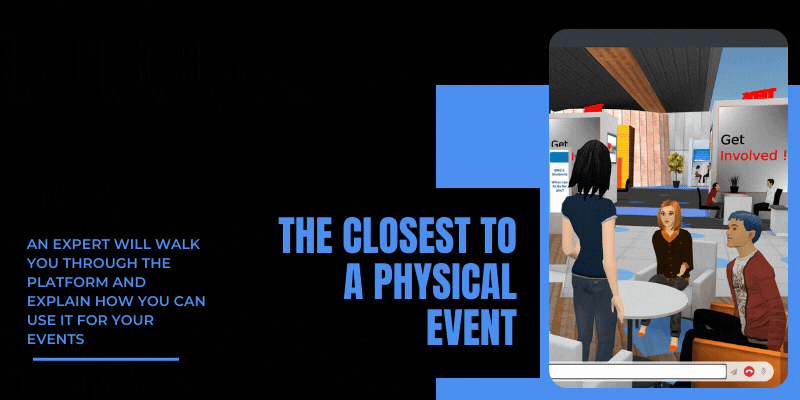As the event industry evolves, virtual event trends have become a primary focus for professionals seeking innovative ways to engage and connect with their audiences. With advancements in technology and shifting societal norms, the landscape of events is transforming at an unprecedented pace.
This blog post will explore the virtual event trends revolutionizing the industry and discuss how they can be leveraged to maximize engagement, reduce costs, increase inclusivity and minimize environmental impact. From cost-effectiveness and enhanced engagement strategies to inclusivity in planning processes, these virtual event trends developments offer exciting opportunities for organizers and attendees alike.
We’ll also explore alternative formats to reduce environmental impact while maintaining a memorable experience for participants. Lastly, we’ll discuss how emerging technologies such as metaverse platforms influence the events industry by offering new frontiers for creative expression and immersive experiences.
Table of Contents:
- Cost-Effectiveness of Virtual Events
- Enhancing Engagement in Virtual Conferences
- Inclusivity in Virtual Event Planning
- Alternative Formats & Environmental Impact Reduction
- Metaverse & Its Influence on the Events Industry
- Frequently Asked Questions Virtual Event Trends
- Conclusion
Cost-Effectiveness of Virtual Events
One significant advantage of virtual event trends is cost-effectiveness. Companies can save substantial travel expenses by hosting online assemblies such as job fairs or conferences, allowing for increased accessibility to content creators and industry peers without the stress of traveling. This budget-friendly approach has made virtual event trends an attractive option for organizations looking to maximize their reach while minimizing costs.
Reduced Travel Expenses for Attendees and Organizers
The shift towards virtual event trends eliminates the need for attendees and organizers to spend money on flights, accommodations, meals, and other related expenses. The cost savings of virtual events means that more individuals can take part without worrying about the financial burden. For example, a recent study found that companies could save up to 75% in total event costs by switching from physical conferences to virtual ones.
- No transportation costs: Attendees can join from anywhere with internet access.
- Affordable ticket prices: Lower overheads often lead to reduced admission fees.
- Fewer logistical challenges: Event planners don’t have to worry about booking venues or coordinating catering services.
Increased Accessibility To A Global Audience
In addition to being cost-effective, virtual conference trends also promote inclusivity by making it easier for individuals around the world—regardless of location— to attend these events. With platforms like MootUp offering no-code solutions for producing and hosting both virtual and hybrid gatherings in the metaverse, event professionals can easily create engaging experiences that cater specifically to global audiences:
- Flexible scheduling: Organizers can offer multiple time slots to accommodate different time zones.
- On-demand content: Attendees can access recorded sessions and materials at their convenience.
- Real-time translation services: Language barriers are minimized, allowing for greater participation from diverse communities.
In conclusion, the cost-effectiveness of virtual events has made them an increasingly popular choice among event industry professionals. By reducing travel expenses and increasing accessibility to a global audience, these gatherings provide numerous benefits that make them an attractive alternative to traditional in-person conferences and meetings.
Virtual events offer a cost-effective solution to both attendees and organizers, allowing for reduced travel expenses and increased accessibility. By implementing interactive elements and innovative solutions for real-time language translation, virtual conferences can further enhance engagement among their participants.
Key Takeaway:
A no-code platform is being developed to create and host virtual and hybrid events in the metaverse. The topic at hand concerns current trends in virtual events, which will be discussed briefly.
Enhancing Engagement in Virtual Conferences
Focusing on engagement is crucial in virtual conference trends. Event planners create memorable experiences by incorporating interactive elements like live polls, thought leadership presentations, expert interviews, panel discussions, concerts and performances. These strategies maintain attendee focus and encourage active participation throughout virtual event platforms.
Interactive Elements to Maintain Attendee Focus
Incorporating various interactive features into virtual events can significantly boost audience engagement levels. Some popular methods include:
- Live polling: Collect real-time feedback from attendees during sessions and adapt content accordingly.
- Q&A sessions: Allow participants to ask questions directly to speakers or panelists through a moderated platform.
- Gamification: Integrate games and challenges that reward attendees for their involvement with points or prizes.
- Networking opportunities: Use AI-powered matchmaking tools to provide dedicated spaces for attendees to connect based on shared interests or industries.
Innovative Solutions for Real-Time Language Translation
To ensure accessibility across diverse audiences worldwide, providing real-time language translation services at virtual conferences is essential. This enables seamless communication among participants who speak different languages while fostering an inclusive environment. Several innovative solutions are available today:
- KUDO: A cloud-based platform that offers live interpretation services for virtual meetings and conferences.
- Interpret: Provides remote simultaneous interpreting (RSI) technology to support multilingual events in real time.
- Microsoft Translator Live Feature: An AI-powered translation tool that enables real-time conversation across multiple languages during online events.
By leveraging these innovative solutions and virtual event platforms, event organizers can effectively enhance engagement levels at virtual conferences while catering to a global audience. The utilization of this technology not only contributes to the success of virtual gatherings but also assists in developing enduring ties among participants from various cultural backgrounds.
By implementing interactive elements and innovative solutions, virtual conferences can be made more engaging for attendees. Inclusivity in Virtual Event Planning is the next step to creating an environment that supports diverse perspectives while addressing mental health concerns among remote workforces.
Key Takeaway:
A no-code platform is being developed to create and host virtual and hybrid events in the metaverse. The topic of interest is the current trends in virtual events, which will be analyzed and incorporated into the platform’s development.
Inclusivity in Virtual Event Planning
As virtual event trends evolve, inclusivity has become a crucial aspect of planning and executing successful online gatherings. Inclusivity extends beyond language considerations; mental health awareness has also become increasingly important within this context. By overcoming these challenges, event organizers can secure future registrations from diverse audiences across different geographies, thereby boosting sales figures and social media shares.
Addressing Mental Health Concerns Among Remote Workforces
The shift towards remote work and the rise of virtual events have brought increased attention to the importance of mental health support for employees and attendees alike. To create an inclusive environment that fosters well-being, event planners should consider incorporating elements such as:
- Mindfulness sessions: Offering guided meditation or mindfulness exercises can help participants reduce stress and maintain focus during the event.
- Built-in breaks: Scheduling regular breaks throughout the day allows attendees to rest their eyes, stretch their legs, or engage in self-care activities without feeling overwhelmed by non-stop content.
- Mental health resources: Providing access to relevant articles or videos on coping strategies can equip participants with the the tools to manage stress effectively during and after the event.
Ensuring Diversity and Inclusivity Through Innovative Planning Strategies
To foster a sense of belonging among all attendees regardless of background or location, virtual events planners need to implement innovative strategies that promote diversity and inclusiveness. Some effective approaches include:
- Catering to various time zones: Schedule live sessions at different times so people worldwide can participate without sacrificing sleep or personal commitments.
- Offering multilingual content: Incorporate real-time language translation services, such as those provided by KUDO, to ensure that attendees can fully engage with the event regardless of their native language.
- Promoting diverse speakers and panelists: Seek out experts from various backgrounds and industries to create a rich tapestry of perspectives that will resonate with a wide range of participants.
Organizations can cultivate an environment where all attendees feel welcome, valued, and engaged by prioritizing inclusivity in virtual event planning. This approach heightens the overall event and contributes to sustained success in this continuously changing virtual event sphere.
In conclusion, virtual event planning should be done with inclusivity and diversity as a priority to ensure that everyone can participate. Moving forward, we can look at alternative event formats that can reduce our environmental impact.
Key Takeaway:
A no-code platform is being developed to create and host virtual and hybrid events in the metaverse. The present state of virtual gatherings is being discussed, with their easy access and cost-effectiveness making them increasingly sought after.
Alternative Formats & Environmental Impact Reduction
One such approach is hosting smaller events throughout the year instead of large-scale conferences or expos. This offers greater flexibility in terms of scheduling and logistics but also helps reduce the total environmental impact associated with organizing massive in-person events.
Hosting Smaller Gatherings Instead of Large-Scale Events
Rather than focusing on one major annual conference, companies can opt for multiple smaller gatherings to reach different audiences and adapt more easily to changing circumstances. These intimate settings provide attendees with an opportunity for deeper engagement and networking while reducing travel-related carbon emissions.
- Better attendee experience due to smaller groups
- Easier adaptation to unforeseen changes or restrictions
- Potential cost savings compared to larger events
Reducing Carbon Footprint via Virtual Event Technology
The rise in popularity of virtual event trends has led many organizations towards embracing online platforms like MootUp as a means of communication akin to PR campaigns. By leveraging these technologies, businesses can significantly lower their environmental footprint by eliminating physical venues’ energy consumption and minimizing waste production from printed materials or catering services.

Furthermore, tech companies now offer ongoing community features that enable attendees to stay connected beyond the duration of individual events, fostering a sense of belonging and collaboration among participants.
By adopting alternative formats and utilizing virtual event technology, event professionals can positively impact both their audience’s experience and the environment.
By leveraging the latest virtual event technology, we can reduce our environmental impact and create smaller events that are still meaningful. As such, it is essential to understand how the metaverse will shape future events and industry trends.
Key Takeaway:
A no-code platform is being developed to create and host virtual and hybrid events in the metaverse. The topic of interest is the current trends in virtual events, which constantly evolve with new technologies emerging daily.
Metaverse & Its Influence on the Events Industry
The metaverse—a virtual reality where people engage with peersâ€,” is gaining traction as an emerging trend in the events industry. Virtual events in the metaverse allow unique experiences and interactions with friends, peers, and celebrities. This new frontier for event planning offers a wealth of opportunities for creative engagement within this immersive digital environment.
Virtual Reality as a New Frontier for Event Planning
With its potential to provide users with a lifelike experience, VR technology has gained immense popularity in recent years. As such, many event planners are now exploring VR technology to enhance their offerings and provide attendees with memorable encounters that transcend traditional boundaries. For example, platforms like MootUp, specifically designed to produce and host virtual conferences in the metaverse, enable participants to interact seamlessly within realistic 3D environments.
- Customizable avatars: Attendees can create personalized avatars representing them during these online gatherings – adding another layer of interactivity while fostering deeper connections among participants.
- Spatial audio: Incorporating spatial audio allows users to experience sound from different directions based on their position within the virtual space – further enhancing realism and immersion levels at these events.
- Variety of venues: With countless venue options available—from conference halls to virtual beaches— event organizers can choose settings that best suit their event’s theme and objectives.
Opportunities for Creative Engagement within the Metaverse
The metaverse offers endless possibilities for creative engagement, allowing event planners to think outside the box when designing interactive experiences. Some examples of innovative activities that could be incorporated into virtual event trends include:
- Virtual networking spaces: By creating dedicated areas where attendees can mingle and converse with one another, organizers can facilitate valuable connections among participants in a more relaxed setting.
- Gamification elements: Incorporating game-like features such as scavenger hunts or quizzes helps maintain attendee interest while encouraging active participation throughout the event.
- Celebrity appearances: The metaverse enables high-profile individuals like celebrities or industry leaders to make special guest appearances at events without physically attending – boosting excitement levels among attendees while generating buzz around these gatherings on social media platforms.
In conclusion, embracing emerging trends like the metaverse allows event professionals to stay ahead of the curve and provides them with unique opportunities for enhancing attendee engagement levels. Staying ahead of the curve by embracing emerging trends is essential for event professionals to remain competitive.
With Mootup, you can create and launch your own Metaverse that is fully customizable to your brand and offers seamless transitions between immersive experiences, providing an always-on virtual world for your visitors.
Key Takeaway:
A no-code platform is being developed to create and host virtual and hybrid events in the metaverse. This article focuses on the latest trends in virtual events, which are becoming increasingly popular due to COVID-19 restrictions forcing people to stay home.
Frequently Asked Questions Virtual Event Trends
What is the trend in the events industry?
The events industry has significantly shifted towards virtual and hybrid event formats. This change has been driven by cost-effectiveness, increased accessibility, enhanced engagement opportunities, and environmental considerations. The rise of metaverse platforms also presents new possibilities for creative event planning.
Why are physical events better than virtual events?
Physical events offer unique advantages over virtual ones, including face-to-face networking opportunities, immersive experiences with tangible products or services, and a sense of camaraderie among attendees. However, weighing these benefits against factors like costs and environmental impact is essential when deciding on an event format.
How sustainable are virtual events?
Virtual events have proven more sustainable than their physical counterparts due to reduced travel-related emissions and resource consumption. Organizers can significantly reduce their carbon footprint by utilizing digital platforms instead of large-scale venues while still providing engaging experiences for attendees.
How do you attract people to virtual events?
To attract people to virtual events, create compelling content that resonates with your target audience. Leverage social media marketing strategies; use eye-catching visuals; provide interactive elements like polls or Q&A sessions; offer incentives such as giveaways or exclusive access; ensure user-friendly technology platforms; collaborate with influential speakers or partners in your industry.
Conclusion
Keeping tabs on the latest fads in virtual events is essential for staying current. With careful planning and preparation, a platform or tool that fits your needs for hosting a successful event, promotional strategies tailored to reach your target audience, and post-event analysis of key metrics from the event itself – you can be sure that you are staying ahead of the curve when it comes to virtual event trends.
Elevate your Metaverse to be “futureproof” with Mootup – a browser-based platform that allows access from smartphones, tablets, laptops, and VR/AR headsets without the need for downloads or software installation, ensuring seamless access across devices.
“Host your next virtual or hybrid event in the metaverse with MootUp, an intuitive no-code platform that makes it easy to create and manage successful events. Take advantage of the latest trends in virtual events today!”

